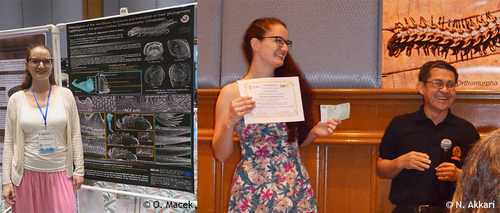Despite being an outlier among the insect-focused BIG4-project, myriapods are a highly interesting group of animals to study and to discuss about. From July 23rd to 26th 2017, myriapodologists from all over the world met in Krabi (Thailand) to present their research on these fascinating creatures during the 17th International Congress of Myriapodology organized by members of the Chulalongkorn University, Bangkok. That was a great opportunity for me and my supervisors Dr. Nesrine Akkari (NHM-Wien) and Dr. Gregory D. Edgecombe (NHM London) to present our first results from the BIG4-project: "Lithobius: a big genus of a small subphylum (Arthropoda, Myriapoda) - phylogenetics and evolutionary history". As preliminary results, we presented the variation and new characters with phylogenetic potential of cephalic microstructures from species of the genus Lithobius.
Besides a great amount of cultural impressions in Thailand, I had the opportunity to listen to interesting scientific talks on myriapods and onychophorans and to give an oral and poster presentations during the 17th ICM. It was an occasion for constructive feedback and stimulating discussions, which are helpful for further project-related research. During the congress’ farewell party, I had the honour to receive the award for the best student poster for my work entitled "Investigation of the mandibular structures and evaluation of their phylogenetic significance in the genus Lithobius (Lithobiomorpha: Lithobiidae)" (DOI: 10.13140/RG.2.2.34492.54401), co-authored by my supervisors. Finally, this meeting was a great chance to discuss the BIG4-project with world’s leading experts on Myriapodology and to contribute a first scientific output of our ongoing research.
Besides a great amount of cultural impressions in Thailand, I had the opportunity to listen to interesting scientific talks on myriapods and onychophorans and to give an oral and poster presentations during the 17th ICM. It was an occasion for constructive feedback and stimulating discussions, which are helpful for further project-related research. During the congress’ farewell party, I had the honour to receive the award for the best student poster for my work entitled "Investigation of the mandibular structures and evaluation of their phylogenetic significance in the genus Lithobius (Lithobiomorpha: Lithobiidae)" (DOI: 10.13140/RG.2.2.34492.54401), co-authored by my supervisors. Finally, this meeting was a great chance to discuss the BIG4-project with world’s leading experts on Myriapodology and to contribute a first scientific output of our ongoing research.


